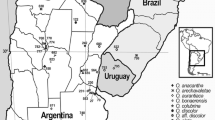Abstract
An analysis of the population genetics of the meiofaunal polychaete Petitia amphophthalma Siewing, 1956, in which the RAPD-PCR method was applied to 103 individuals from eight populations, some of them very far apart (Atlantic: Florida, Tenerife, France; Mediterranean: two Greek islands, Tunisia; Red Sea: Egypt), gave closely reproducible results. In the band patterns produced with 13 decamer primers, a total of 195 genetic characters was detected. The data were evaluated by a number of methods, including the cluster programs UPGMA, WPGMA and neighbour-joining. The detected genetic distances between the populations vary between 58.9 and 66.6, but 97% of the genetic characters, although polymorphic, are found in at least two populations and usually in all the others as well. Phenograms of the analyses find four population clusters [Florida, France (Atlantic), the Mediterranean and Tenerife]. They are, however, not completely congruent and show low bootstrap values at the junction points of the clusters (with the exception of the Tenerife cluster). Mediterranean P. amphophthalma form a cohesive population, although within it the genetic distances are graded in parallel with the geographic distances between the sites. The colonization of Tenerife, an island of relatively recent volcanic origin, can be taken as evidence that this meiofaunal species can become dispersed not only along coastlines but also across expanses of open water. However, the severely restricted variability of these populations implies that in this case a founder effect has operated, and that transport over open water is not a routine event but extremely rare. The absence of the species on the Australian coast and, for instance, on the Galapagos Islands indicates that there has been no continuous gene flow across the oceans. The idea that all the populations investigated belong to one cosmopolitan species is discussed.
Similar content being viewed by others
Author information
Authors and Affiliations
Additional information
Received: 17 October 1997 / Accepted: 15 April 1998
Rights and permissions
About this article
Cite this article
von Soosten, C., Schmidt, H. & Westheide, W. Genetic variability and relationships among geographically widely separated populations of Petitia amphophthalma (Polychaeta: Syllidae). Results from RAPD-PCR investigations. Marine Biology 131, 659–669 (1998). https://doi.org/10.1007/s002270050358
Issue Date:
DOI: https://doi.org/10.1007/s002270050358




